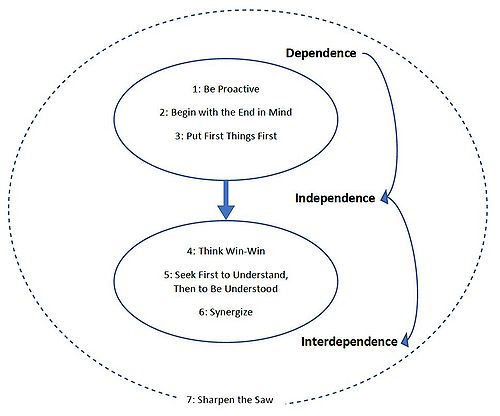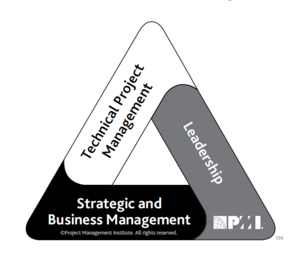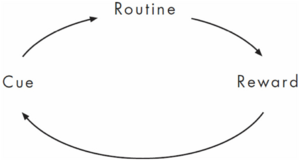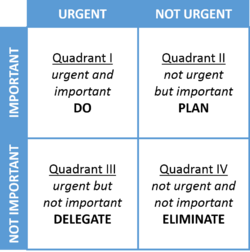The 7 Habits of Highly Effective People
| Line 93: | Line 93: | ||
|} | |} | ||
| − | = How to achieve new habits = | + | = How to achieve these/new habits = |
[[File:TheHabitLoop.png|300px|thumb|right| The Habit Loop <ref name="Duhigg"> Duhigg, C. (2012). The power of habit: Why we do what we do in life and business. New York: Random House. </ref> (pp. 312-322)]] | [[File:TheHabitLoop.png|300px|thumb|right| The Habit Loop <ref name="Duhigg"> Duhigg, C. (2012). The power of habit: Why we do what we do in life and business. New York: Random House. </ref> (pp. 312-322)]] | ||
| − | + | '''1: Be Proactive:''' | |
| − | + | <ref name="Covey"/> (pp. 31-44) | |
| − | : | + | '''2: Begin with the End in Mind:''' |
| + | <ref name="Covey"/> (pp. 45-73) | ||
| − | : | + | '''3: Put First Things First:''' |
| − | + | <ref name="Covey"/> (pp. 73-90) | |
| − | : | + | |
| − | + | ||
| + | '''4: Think Win-Win:''' | ||
| + | <ref name="Covey"/> (pp. 102-119) | ||
[[File:CoveyMatrix.png|250px|thumb|right| Time Management Matrix <ref name="Matrix"> First things first (book). (2020, November 17). Retrieved February 27, 2021, from https://en.wikipedia.org/wiki/First_Things_First_(book) </ref>]] | [[File:CoveyMatrix.png|250px|thumb|right| Time Management Matrix <ref name="Matrix"> First things first (book). (2020, November 17). Retrieved February 27, 2021, from https://en.wikipedia.org/wiki/First_Things_First_(book) </ref>]] | ||
| + | |||
| + | |||
| + | '''5: Seek First to Understand, Then to Be Understood:''' | ||
| + | <ref name="Covey"/> (pp. 119-133) | ||
| + | |||
| + | '''6: Synergize:''' | ||
| + | <ref name="Covey"/> (pp. 133-146) | ||
| + | |||
| + | '''7: Sharpen the Saw:''' | ||
| + | <ref name="Covey"/> (pp. 133-146) | ||
| + | |||
| + | |||
| + | == Suggestion how to implement the tool in project management == | ||
= Limitations = | = Limitations = | ||
Revision as of 10:58, 27 February 2021
Created by Lena Maria Thyen (s202969)
Contents |
Abstract
The skills and competences of a project manager are crucial for a project to succeed. Besides technical project management skills and strategic and business management skills, a successful and effective project manager is also characterized by leadership skills and competences. Some of the most important leadership skills, qualities and competences include: being optimistic and positive, being collaborative, being able to managing relationships and conflicts, asking and listening, being a problem solver, being a life-long learner who is results- and action-oriented, being able to focus on the important things, being able to have fun and share humor effectively with team members [1] (pp. 51-62). These skills and competences are discussed in the personality development book The 7 Habits of Highly Effective People, which the American author Stephen Covey wrote in 1990. Covey describes an inside-out approach that focuses on character ethics rather than personality ethics. According to Covey, personal and professional success is going to be achieved by adopting these seven habits: 1) be proactive, 2) begin with the end in mind, 3) put first things first, 4) think win-win, 5) seek first to understand, then to be understood, 6) synergize, 7) sharpen the saw. When implementing these habits into the character, three stages 1) dependence, 2) independence and 3) interdependence are passed in succession, which Covey describes as the maturity continuum. The fact that these skills and competences can be trained as habits and thus be integrated into the character enables employees and thus companies to achieve increased effectiveness in project management through the use of this personality development tool [2].
The 7 Habits of Highly Effective People

1: Be Proactive: [2] (pp. 31-44)
2: Begin with the End in Mind: [2] (pp. 45-73)
3: Put First Things First: [2] (pp. 73-90)
4: Think Win-Win: [2] (pp. 102-119)
5: Seek First to Understand, Then to Be Understood: [2] (pp. 119-133)
6: Synergize: [2] (pp. 133-146)
7: Sharpen the Saw: [2] (pp. 133-146)
The role of a project manager and the importance of it’s competences / habits

| Habits
1 to 7 |
Leadership skills / competences |
|---|---|
| 1: Be Proactive |
|
| 2: Begin with the End in Mind |
|
| 3: Put First Things First |
|
| 4: Think Win-Win |
|
| 5: Seek First to Understand, Then to Be Understood |
|
| 6: Synergize |
|
| 7: Sharpen the Saw |
|
How to achieve these/new habits

1: Be Proactive: [2] (pp. 31-44)
2: Begin with the End in Mind: [2] (pp. 45-73)
3: Put First Things First: [2] (pp. 73-90)
4: Think Win-Win: [2] (pp. 102-119)

5: Seek First to Understand, Then to Be Understood:
[2] (pp. 119-133)
6: Synergize: [2] (pp. 133-146)
7: Sharpen the Saw: [2] (pp. 133-146)
Suggestion how to implement the tool in project management
Limitations
Conclusion
Annotated Bibliography
Project Management Institute (Ed.). (2013). A guide to the project management body of knowledge (PMBOK® guide) - 5th Edition. Newtown Square, Penn.: Project Management Institute.
This book provides the fundamentals of project management with focus on performing projects with effective collaboration and the most valuable knowledge on a wide range of projects. The as best recognized practice for project managers are collected in this book and gives project managers the essential tools to practice project management and deliver organizational results.
Bernacer, J., & Murillo, J. I. (2014). The Aristotelian conception of habit and its contribution to human neuroscience. Frontiers in Human Neuroscience, 8. doi:10.3389/fnhum.2014.00883.
This journal gives an in-depth knowledge and understanding of how habits and human neuroscience are linked. It provides a good understanding what habits are and how they are composed.
R. L., Kliem (2008). Effective communications for project management. New York: Auerbach Publications. doi:https://doi.org/10.1201/9781420062489.
This book provides guidelines for effective communication in project management. Tools for active and effective listening are presented which could be interesting as these can help to implement habit number 5: Seek First to Understand, Then to Be Understood of the 7 habits of highly effective people.
Barrett, D. (2013). Leadership communication 4th Edition. New York: McGraw-Hill Education.
This book is about high effective and productive communication for leaders. It provides theoretical background and guidelines how to gain appropriate communication skills which are relevant for leaders.
Maylor, H. (2010). Project Management. Harlow: Financial Times Prentice Hall.
This book is about fundamentals of project management. It provides a deep insight into effective leadership, team management and explains the importance of different roles in a high performing group with focus on different types of projects and situations.
Wisdom For Life (Director). (2018, January 07). The 7 Habits of Highly Effective People Summary [Video file]. Retrieved February 20, 2021, from https://www.youtube.com/watch?v=WFc08j9eorQ&t=4s.
and
Wisdom For Life (Director). (2018, January 07). The 7 Habits of Highly Effective People Summary (part 2) [Video file]. Retrieved February 20, 2021, from https://www.youtube.com/watch?v=5LbCRx1UbWY&t=1s.
In these videos (part 1 and part 2) the essential principle behind The 7 habits of highly effective people by Covey is given in an easily understandable way to get an overview of this personality development tool.
References
- ↑ 1.0 1.1 1.2 Project Management Institute, Inc.. (2017). Guide to the Project Management Body of Knowledge (PMBOK® Guide) (6th Edition). Project Management Institute, Inc. (PMI). Retrieved from https://app.knovel.com/hotlink/toc/id:kpGPMBKP02/guide-project-management/guide-project-management
- ↑ 2.00 2.01 2.02 2.03 2.04 2.05 2.06 2.07 2.08 2.09 2.10 2.11 2.12 2.13 2.14 2.15 2.16 Covey, S. R. (1990). The 7 habits of highly effective people. New York, USA: Fireside.
- ↑ Duhigg, C. (2012). The power of habit: Why we do what we do in life and business. New York: Random House.
- ↑ First things first (book). (2020, November 17). Retrieved February 27, 2021, from https://en.wikipedia.org/wiki/First_Things_First_(book)
Cite error: <ref> tag with name "Carlone" defined in <references> is not used in prior text.
Cite error: <ref> tag with name "Aristol" defined in <references> is not used in prior text.